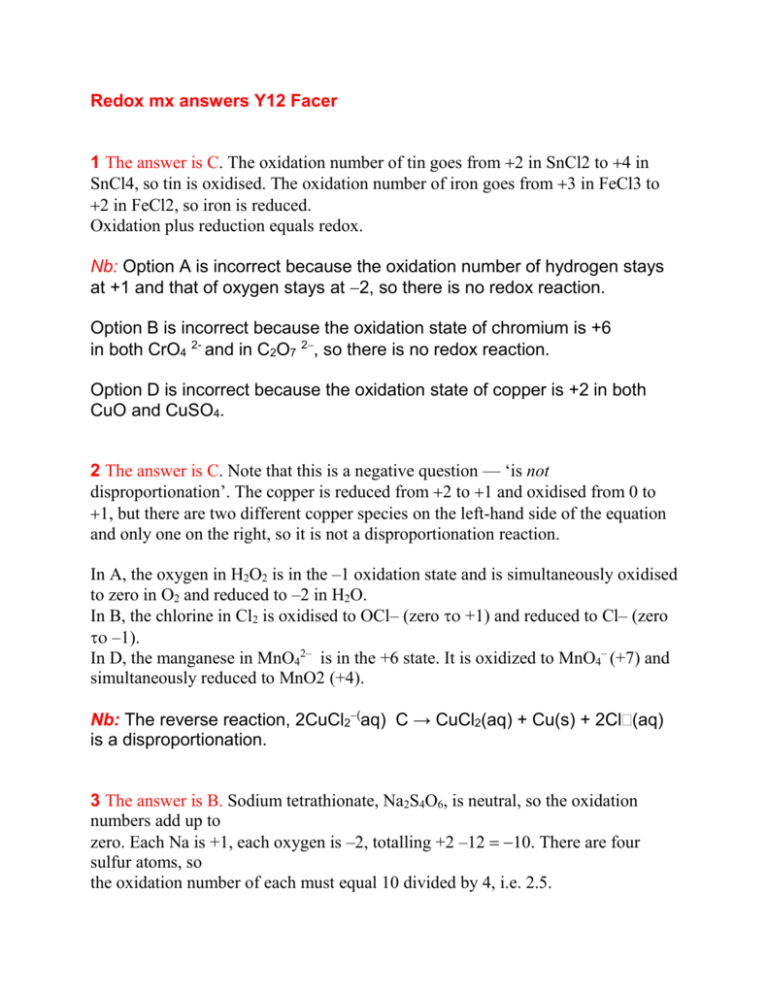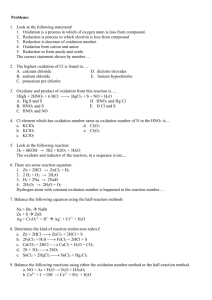redox mx Y12 ans
advertisement

Redox mx answers Y12 Facer 1 The answer is C. The oxidation number of tin goes from 2 in SnCl2 to 4 in SnCl4, so tin is oxidised. The oxidation number of iron goes from 3 in FeCl3 to 2 in FeCl2, so iron is reduced. Oxidation plus reduction equals redox. Nb: Option A is incorrect because the oxidation number of hydrogen stays at +1 and that of oxygen stays at 2, so there is no redox reaction. Option B is incorrect because the oxidation state of chromium is +6 in both CrO4 2- and in C2O7 2, so there is no redox reaction. Option D is incorrect because the oxidation state of copper is +2 in both CuO and CuSO4. 2 The answer is C. Note that this is a negative question — ‘is not disproportionation’. The copper is reduced from 2 to 1 and oxidised from 0 to 1, but there are two different copper species on the left-hand side of the equation and only one on the right, so it is not a disproportionation reaction. In A, the oxygen in H2O2 is in the –1 oxidation state and is simultaneously oxidised to zero in O2 and reduced to –2 in H2O. In B, the chlorine in Cl2 is oxidised to OCl– (zero +1) and reduced to Cl– (zero –1). In D, the manganese in MnO42– is in the +6 state. It is oxidized to MnO4– (+7) and simultaneously reduced to MnO2 (+4). Nb: The reverse reaction, 2CuCl2(aq) C → CuCl2(aq) + Cu(s) + 2Cl(aq) is a disproportionation. 3 The answer is B. Sodium tetrathionate, Na2S4O6, is neutral, so the oxidation numbers add up to zero. Each Na is +1, each oxygen is –2, totalling +2 –12 10. There are four sulfur atoms, so the oxidation number of each must equal 10 divided by 4, i.e. 2.5. 4 The answer is A. The oxidation numbers in potassium superoxide add up to zero and, as it is a superoxide, the oxidation number of oxygen is not –2. (It is also not –2 in peroxides.) The oxidation number of potassium is always 1, so the oxidation numbers of the two oxygen atoms must add up to –1. Therefore, the oxidation number of oxygen in potassium superoxide is (–1/2). 5 The answer is A. The oxidation number of manganese changes from 7 to 2, which is a change of five. Therefore, there must be five electrons in the equation. An alternative way to work this out is that the half-equation must balance for charge. The charge on the right-hand side is +2, so that on the left-hand side must also be +2. This is achieved if there are five electrons: (1-)5+ (82 Reminder: writing +2 Ξ 2+ whenever writing charges on ions or oxidation states








